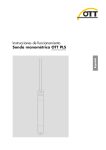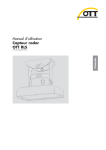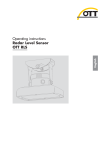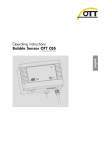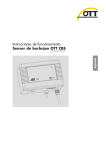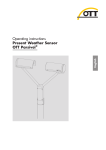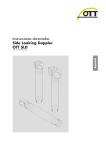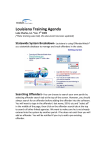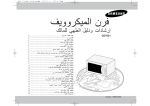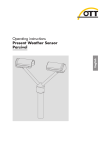Download Operating instructions Pressure Probe OTT PLS
Transcript
English Operating instructions Pressure Probe OTT PLS We reserve the right to make technical changes and improvements without notice. Table of contents 1 Scope of Supply 4 2 Order Numbers 4 3 Basic safety instructions 5 4 Introduction 6 5 Installing the pressure probe 8 5.1 5.2 5.3 5.4 5.5 5.6 5.7 5.8 5.9 Installation type A: fixing the pressure probe into a protective device Installation type B: hanging pressure probe Connecting humidity absorbing system Wire assignment of the pressure probe cable Connecting the OTT PLS to any datalogger using an SDI-12 interface Connecting the OTT PLS to any datalogger using a 4 … 20 mA interface Determining the maximum load resistance at the 4 … 20 mA interface Note on using the 4 … 20 mA interface Note on using the RS-485 interface 6 SDI-12 Commands and Responses 6.1 Standard commands 6.2 Advanced SDI-12 commands 8 9 10 10 11 11 11 12 12 13 13 15 7 Carrying out maintenance work 20 8 Searching for disruptions/troubleshooting 21 9 Repair 22 10 Note about the disposal of old units 22 11 Technical Data 23 Appendix A – Connecting the OTT PLS to the LogoSens 2 or DuoSens using an SDI-12 or RS-485 interface 25 Appendix B – Connecting the OTT PLS to the LogoSens 2 or DuoSens using a 4 … 20 mA interface 27 Appendix C – Installing the OTT FAD 5 humidity absorbing system 29 Appendix D – Installing the OTT FAD 4PF humidity absorbing system 31 Appendix E – Declaration of conformity for the OTT PLS 32 3 1 Scope of supply 䊳 OTT PLS – 1 Pressure probe with a ceramic, capacitive, relative pressure measuring cell and shielded pressure probe cable with pressure compensation capillary and Kevlar core for length stabilization. Pre-fabricated cable end with transport protection against moisture. – 1 Set of operating instructions – 1 Factory acceptance test certificate (FAT) 2 Order numbers 䊳 OTT PLS OTT PLS pressure probe – Version with 4 … 20 mA interface – Version with SDI-12 interface – Version with RS-485 interface (SDI-12 protocol) Required order information – Measuring range: 0 … 4 0 … 10 0 … 20 0 … 40 0 … 100 – Cable length: 1 … 200 䊳 Accessories 4 63.037.001.9.0 m; m; m; m; m m Humidity absorbing system OTT FAD 4PF – desiccant cartridge in clear container with connection tube for pressure compensation capillary 63.025.021.4.2 Humidity absorbing system OTT FAD 5 – connecting box (pressure probe cable ↔ connection cable datalogger/voltage supply) with desiccant cartridge 63.037.025.3.2 Dessicant cartridge – replacement cartridge in transport container 97.100.066.4.5 Cable attachment 96.140.173.9.5 Connection cable – twisted pair construction; LiYY – PVC, black – 2 x 2 x 0.75 mm2 – unshielded 97.000.040.9.5 Connection cable – twisted pair construction; FD CP (TP) – PVC, gray – 2 x 2 x 0.5 mm2 – shielded 97.000.039.9.5 3 Basic safety information 䊳 Read these operating instructions before using the OTT PLS for the first time! Make yourself completely familiar with the installation and operation of the OTT PLS! Retain these operating instructions for later reference. 䊳 The OTT PLS is used for measuring the water level of ground and surface waters in hydrometry. Only use the OTT PLS as described in these operating instructions! For further information, ➝ see Chapter 4, Introduction. 䊳 Note all the detailed safety information given within the individual work steps. All safety information in these operating instructions are identified with the warning symbol shown here. 䊳 Ensure the electrical, mechanical, and climatic specifications listed in the technical data are adhered to. For further information ➝ see Chapter 11, Technical data. 䊳 Do not make any changes or retrofits to the OTT PLS. If changes or retrofits are made, all guarantee claims are voided. 䊳 Have a faulty OTT PLS inspected and repaired by our repair center. On no account carry out repairs yourself! For further information ➝ see Chapter 9, Repair. 䊳 Dispose of the OTT PLS properly after taking out of service. On no account put the OTT PLS into the normal household waste. For further information ➝ see Chapter 10, Note about the disposal of old units. 5 4 Introduction The OTT PLS pressure probe is used for precisely measuring the water level of ground and surface waters. The pressure probe uses the hydrostatic pressure of the water column above a relative pressure measuring cell to do so. A pressure compensation capillary in the pressure probe cable gives the measuring cell the current ambient air pressure as a reference. Erroneous measurement results due to atmospheric air pressure fluctuations are thus eliminated. The OTT PLS can be supplied with various measuring ranges: 䊳0 䊳0 䊳0 䊳0 䊳0 … … … … … 4 10 20 40 100 m m m m m water water water water water column column column column column (0 (0 (0 (0 (0 ... ... ... ... ... 0.4 bar) 1 bar) 2 bar) 4 bar) 10 bar) Furthermore, the pressure probe can be supplied with either an analog or digital interface: 䊳 4 … 20 mA interface (with additional RS-485 interface (SDI-12 protocol) for configuring the 4 … 20 mA interface*) 䊳 SDI-12 interface 䊳 RS-485 interface (SDI-12 protocol) The pressure probe with the SDI-12/RS-485 interface can be configured via the SDI-12 transparent mode of a datalogger. For example, a reference value or offset value can be entered when starting up the device. With the 4 … 20 mA version, it is possible to scale the measured value output to a smaller measuring range using the additional RS-485 interface available (SDI-12 protocol). A particular feature is that the pressure probe measures the water temperature as well as the hydrostatic pressure of the water column and thus yields highly precise and reproduceable measurement results by compensating the effects of temperature, specific density of the water and the local gravitational acceleration at the specific station. (For this, the specific density and local gravitational acceleration are entered as required during startup.) At the SDI-12 and RS-485 interfaces, the OTT PLS outputs either the water level (compensated) or the hydrostatic pressure as well as the water temperature: at the 4 … 20 mA interface, either the water level (compensated) or hydrostatic pressure. Measurement units can be set with SDI-12 commands as m / cm / ft (water level measurement), mbar / psi (pressure measurement) and °C / °F (temperature measurement). The properties mentioned enable the universal operation of the pressure probe: for example for connection to a datalogger, controlling pen recorders, alarm devices, switching contacts, and, together with a display, for the display of measured values. A humidity absorbing system for drying the surrounding air that enters the pressure compensation capillary is available as an accessory. * No parallel operation of the interfaces 6 Fig. 1: Main layout of a water level station with the OTT PLS pressure probe. Attachment hooks Cable suspension (accessory) Pressure probe cable (e. g. to datalogger) Water level Pressure compensation capillary Pressure probe OTT PLS Pressure-sensitive membrane of the relative pressure measuring cell 7 5 Installing the pressure probe The OTT PLS pressure probe can be used in a variety of ways, for example in observation wells and boreholes from 1" diameter, in shafts, open waterways, and in waterways that do not always hold water. Caution We do not recommend installing the pressure probe in the vicinity of port facilities, industrial waste water discharges or areas with heavy chemical contamination. The pressure probe is constructed from high-quality stainless steel and plastic. However, depending on the mounting location, damaging corrosion can arise. For more information on the materials used, see Chapter 11 "Technical data". The pressure probe can be installed in two ways: 䊳 fixed in an individual protective device, built on location, or 䊳 hung on the pressure probe cable. Caution No moisture should be allowed to enter the pressure compensation capillary of the pressure probe cable during installation! Very high air humidity can also lead to the formation of water droplets in the pressure compensation capillary due to temperature changes. These inevitably lead to unusable measurement results! As a result, ensure the transport protection is left on the cable end during the whole time it is being laid! 5.1 Installation type A: fixing the pressure probe into a protective device In flowing waters or waterways with a swell, the pressure probe must be fixed. With strong currents (> 0.5 … 1 m/s) the hydrodynamic influences of the station have to be considered in the installation. Depending on the version and mounting of the individual components, overpressure or negative pressure can arise that can affect the measurement result. 䡵 Determine the minimum and maximum water level at your station (e.g. staff gauge, contact gauge). Use both values to specify the probe position. The following conditions must be fulfilled: – position the probe below the minimum water level if possible; – difference between max. water level and position of the probe < measuring range of the probe. 䡵 Fix the pressure probe according to your individual requirements in a protective device, as shown in Figure 2, for example. Note The fine setting of the probe position is carried out, for example, by entering a reference or offset value (with SDI-12/RS-485 interface) or using a scaling function of the datalogger connected. 8 Fig. 2: Installation example of the OTT PLS pressure probe in open waterways. With waterways with currents or swell, a fixing pin is used to securely fasten the probe. Push the fixing pin through the holes in the black protective cap. Plastic protective tube OTT PLS Fixing pin 5.2 Installation type B: hanging pressure probe See also Figure 1. 䡵 Determine the minimum and maximum water level at your station (e.g. staff gauge, contact gauge). Use both values to specify the probe position. The following conditions must be fulfilled: – position the probe below the minimum water level if possible; – difference between max. water level and position of the probe < measuring range of the probe. 䡵 Fix the cable attachment (accessory) at a suitably sized attachment point. 䡵 Carefully lower the pressure probe on the pressure probe cable to the specified depth. There are markings on the cable every 0.25 m to assist orientation. 䡵 Lay the pressure probe cable in the opened clamping jaws of the cable attachment as shown in Figure 1 and secure the pressure probe cable by pushing the clamping jaws together. The mechanical longitudinal stability required is provided by Kevlar fibers inside the pressure probe cable. Caution: maximum hanging depth: 50 m. (greater depths on request). Notes 䊳 The fine setting of the probe position is carried out, for example, by entering a reference or offset value (with SDI-12/RS-485 interface) or using a scaling function of the datalogger connected. It is thus sufficient in many applications to position the probe approximately. 䊳 If the pressure probe cable ends in the immediate vicinity of the cable attachment: fix the Kevlar fibers at a suitable point in addition! 9 5.3 Connecting humidity absorbing system A humidity absorbing system must be installed for drying the surrounding air that enters the pressure compensation capillary of the pressure probe cable! See Appendix C and D. Caution Humidity entering the pressure compensation capillary leads to unusable measurement results! 5.4 Wire assignment of the pressure probe cable Fig. 3: Wire assignment of the OTT PLS pressure probe cable. Pressure compensation capillary Cable shielding Pressure probe cable Kevlar fibers Color red blue gray green orange Assignment +9,6 … 28 GND SDI-12 Data RS-485 A RS-485 B V DC Caution The factory assembled pressure probe cable should only be shortened with a suitable wire stripping tool! Danger of damaging the cable! Recommendation: Store excess cable in loops if necessary! If necessary, the pressure probe cable can be lengthened. For this purpose, use a suitable junction box (e. g. OTT FAD 5). This should also be large enough to hold the humidity absorbing system. The maximum cable length for the RS-485 interface and the 4 … 20 mA interface is 1,000 m. Recommended cable type for the RS-485 interface: shielded, twisted-pair cable. The wires intended for the power supply can be twisted pair, but do not have to be. Recommended cable type for the 4 … 20 mA interface: unshielded, low-voltage cable. If the additional RS-485 interface (configuring the 4 … 20 mA interface) is also to be fed to the datalogger, a twisted pair cable is also necessary in this case. Suitable wire sizes 䊳 Up to 500 m cable length: 2 x 2 x 0.5 mm2 (41 Ohm/1,000 m) 䊳 500 to 1,000 m cable length: 2 x 2 x 0.75 mm2 (27 Ohm/1,000 m) 10 5.5 Connecting the OTT PLS to any datalogger using an SDI-12 interface 䡵 Connect the OTT PLS to an SDI-12 input of the datalogger. Follow the datalogger handbook when doing this. Refer to Figure 4 for the wire assignments of the OTT PLS. Wires used: red, blue, and gray. The maximum length of the cable is 100 m. 䡵 To achieve better protection against overloads, you can optionally connect the cable shielding to a grounding point/equipotential busbar. Fig. 4: Wires used with an SDI-12 interface. Cable shielding +9,6 … 28 V DC (red) GND (blue) SDI-12 Data (gray) The SDI-12 commands and responses used with the OTT PLS can be found in Chapter 6, SDI-12 Commands and Responses. 5.6 Connecting the OTT PLS to any datalogger using a 4 … 20 mA interface 䡵 Connect the OTT PLS to a 4 … 20 mA input of the datalogger. Follow the datalogger handbook when doing this. Refer to Figure 5 for the connection assignments of the OTT PLS. Wires used: red and blue. Maximum cable length: dependent on the level of the supply voltage and size of the burden (load resistor). Ensure that the ohmic resistance of the pressure probe cable together with any burden present does not exceed the maximum permitted load resistance (see Chapter 5.7). The upper limit for the cable length is 1,000 m in all cases. 䡵 To achieve better protection against overloads, you can optionally connect the cable shielding to a grounding point/equipotential busbar. Fig. 5: Wires used with a 4 … 20 mA interface. If the OTT PLS is to be configured via the RS-485 interface, the green and orange wires are required in addition. Cable shielding +9,6 … 28 V DC (red) GND (blue) 5.7 Determining the maximum load resistance at the 4 … 20 mA interface The load resistance (burden + ohmic resistance of the connection cable) connected to the OTT PLS must not exceed a specific maximum value. This value depends on the level of the supply voltage of the OTT PLS. If the load resistance is greater, the loop current* can no longer be evaluated. Smaller load resistances are allowed. ^ measured value) * Due to the imposed (controlled) current by the OTT PLS of the 4 … 20 mA interface (= 11 䡵 See the following diagram for the maximum load resistance applicable to your power supply. Alternatively, the maximum load resistance can be calculated according to the formula: Rload (max) = (Usupply – 8.5 V )/ 0.025 A Example: Power supply 24 Volt ➝ max. load resistance 620 Ohm. The OTT PLS delivers a loop current corresponding to the measured value for a load resistance of up to 620 Ohm. 䡵 Dimension the connected electrical circuit accordingly. Check the input resistance of the connected peripheral device for this purpose. Fig. 6: Diagram to determine the maximum load resistance as a function of the power supply. Minimum power supply: 9.6 V Maximum power supply: 28 V Burden tolerance: 0.1 %/15 ppm. (Burden = load resistor). R Ω 1000 900 800 700 Example 600 500 400 300 200 100 0 10 15 20 25 30 U V 5.8 Note on using the 4 … 20 mA interface 䊳 Behavior when switching on the 4 … 20 mA interface After providing the supply voltage, it takes approx. 7 seconds for the loop current to take on the value proportional to the water level. (In the first 7 seconds, the loop current is between 3 and 4 mA.) Afterwards, the pressure probe updates the loop current every 2 seconds. 䊳 Loop current when configuring the 4 … 20 mA interface If there is a communication via the RS-485 interface, the loop current is higher than the appropriate level for the measured value by several mA. After the end of the communication, it takes approx. 250 ms until the loop current takes on the appropriate value again. 5.9 Note on using the RS-485 interface The RS-485 interface can only be used with OTT dataloggers. In this case, the transmission protocol via the physical RS-485 interface is the SDI-12 protocol. Connecting OTT PLS via the RS-485 interface to the OTT LogoSens/DuoSens ➝ see Appendix A, Method B. 12 6 SDI-12 Commands and Responses 6.1 Standard commands All SDI-12 standard commands are implemented in the OTT PLS. The following SDI-12 standard commands are relevant for the operation of the OTT PLS: Command Response Description a! a<CR><LF> Confirmation active a – sensor address; factory setting = 0 aI! al3ccccccccmmmmmm … … vvvxxxx<CR><LF> Send identification a – Sensor address l3 – SDI-12 protocol version cccccccc – manufacturer identification (company name) mmmmmm – Sensor identification vvv – Sensor version (firmware) xxxxxx – Serial number Answer OTT PLS = 013OTTHACH PLS000100123456 aAb! b<CR><LF> Change sensor address a – old sensor address b – new sensor address ?! a<CR><LF> Query sensor address a – sensor address aM! atttn<CR><LF> and after 2 seconds a<CR><LF> Starting the measurement a – Sensor address ttt – Time in seconds until the sensor has determined the measurement result Answer OTT PLS = 002 n – Number of measured values Answer OTT PLS = 2 a<CR><LF> – Service request aD0! a<value1><value2><CR><LF> Send data a – sensor address <value1> – level/pressure value measured value formats: m ➝ pbbbb.eee cm ➝ pbbbbbbbb ft ➝ pbbbbb.ee mbar ➝ pbbbbbb.e psi ➝ pbbbb.eee <value2> – temperature value measured value formats: °C and °F ➝ pbbb.e p – sign (+,–) b – numbers (before the decimal point) Output is without leading zeroes! e – digits after the decimal point aMC! atttn<CR><LF> and after 2 seconds a<CR><LF> Start the measurement and request CRC (Cyclic Redundancy Check). For details see command aM!. The answer to the following aD0! command is extended by a CRC value: a<value1><value2><CRC><CR><LF> aC! atttnn<CR><LF> Start concurrent measurement (simultaneous measurement with multiple sensors on one bus feed). For more details, see command aM!. The number of measured values in the answer to this command is two-digit: nn = 02. 13 Command Response Description aCC! atttnn<CR><LF> Start concurrent measurement (simultaneous measurement with multiple sensors on one bus feed) and request CRC (Cyclic Redundancy Check). For more details, see command aM!. The number of measured values in the answer to this command is two-digit: nn = 02. The answer to the following aD0! command is extended by a CRC value: a<value1><value2><CRC><CR><LF> aM1! atttn<CR><LF> and immediately afterwards a<CR><LF> Query status of the last measurement – Sensor address a ttt – Time in seconds until the sensor has made the result of the system test available Answer OTT PLS = 000 – Number of measured values n Answer OTT PLS = 1 a<CR><LF> – Service request aD0! a<value><CR><LF> Send data (after aM1!, aMC1!, aC1!, aCC1!) a – Sensor address <value> – Status of the last measurement +0 = no hardware defect found +128 = flash memory defective +256 = Watchdog error +512 = memory defective +1024 = pressure cell defective +2048 = D/A converter defective aMC1! atttn<CR><LF> and immediately afterwards a<CR><LF> Query the status of the last measurement and request CRC (Cyclic Redundancy Check). For details see command aM1!. The answer to the following aD0! command is extended by a CRC value: a<value><CRC><CR><LF> aC1! atttnn<CR><LF> Query the status of the last measurement in concurrent mode (simultaneous measurement with multiple sensors on one bus feed). For more details, see command aM! The number of measured values in the answer to this command is two-digit: nn = 02. aCC1! atttnn<CR><LF> Query the status of the last measurement in concurrent mode (simultaneous measurement with multiple sensors on one bus feed) and request CRC (Cyclic Redundancy Check). For more details, see command aM! The number of measured values in the answer to this command is two-digit: nn = 02. The answer to the following aD0! command is extended by a CRC value: a<value><CRC><CR><LF> aV! atttn<CR><LF> and immediately afterwards a<CR><LF> Carrying out a system test a – Sensor address ttt – Time in seconds until the sensor has made the result of the system test available Answer OTT PLS = 000 n – Number of measured values Answer OTT PLS = 1 a<CR><LF> – Service request 14 Command Response Description aD0! a<value><CR><LF> Send data (after aV!) a – Sensor address <value> – Result of the system test +0 = no hardware defect found +128 = flash memory defective +256 = Watchdog error +512 = memory defective +1024 = pressure cell defective +2048 = D/A converter defective More information on the SDI-12 standard commands can be found in the document SDI-12; A Serial-Digital Interface Standard for Microprocessor-Based Sensors, Version 1.3 (see Internet pagewww.sdi-12.org). 6.2 Advanced SDI-12 commands All advanced SDI-12 commands begin with an "O" for OTT. With these commands, it is possible to configure the OTT PLS using the transparent mode of a datalogger. Command Response Description 䊳 Setting/reading the level/pressure measurement values aOSU<value>! aOSU! a<value><CR><LF> a<value><CR><LF> Set unit Read out unit a – Sensor address <value> – Units for level +0 = m; factory setting +1 = cm +2 = ft The level measurement is carried out with compensation for water density, water temperature and local gravitational acceleration. Units for pressure measurement +3 = mbar +4 = psi Pressure measurement is carried out without compensation! Caution If settings for the parameters "Offset", "Reference value", "Upper limit" or "Lower limit" have been made before changing the unit, they must be reset! There is no automatic conversion of the parameters set! 䊳 Setting/reading the temperature value units aOST<value>! aOST! a<value><CR><LF> a<value><CR><LF> Set unit Read out unit a – Sensor address <value> – +0 = °C; factory setting +1 = °F 15 Command Response Description 䊳 Set/read local gravitational acceleration aOXG<value>! aOXG! a<value><CR><LF> a<value><CR><LF> Set local gravitational acceleration Read out local gravitational acceleration a – Sensor address <value> – b.eeeee b – numbers before the decimal point c – numbers after the decimal point Value range: 9.78036 … 9.83208 m/s2 factory setting = 9.80665 m/s2 The gravitational acceleration at the earth's surface fluctuates between 9.78036 m/s2 at the equator and 9.83208 m/s2 at the poles. Also, it decreases by 0.003086 m/s2 for each kilometer of elevation above sea level. Formula for the local gravitational acceleration g in m/s2 : g = 9.780356 (1 + 0.0052885 sin2 α – 0.0000059 sin2 2α) – 0.003086 h α latitude; h = height above sea level in km (Source: Jursa, A.S., Ed., Handbook of Geophysics and the Space Environment, 4th ed., Air Force Geophysics Laboratory, 1985, pp. 14-17). Example Local gravitational acceleration in Kempten: At a height above sea level of 669 m and a latitude of 47.71°, a local gravitational acceleration of 9.80659 m/s2 results. Note The OTT PLS is preset to an average value for Germany (Kassel). The measurement deviation caused by gravitational acceleration is ±3 mm in Germany (Flensburg – Oberstdorf). This measurement error is compensated by inputting the local gravitational acceleration. 䊳 Set/read average water density aOXR<value>! aOXR! a<value><CR><LF> a<value><CR><LF> Set medium water density Read out medium water density a – Sensor address <value> – b.eeeee b – numbers before the decimal point a – numbers after the decimal point Value range: 0.50000 … 2.00000 kg/dm3 Factory setting = 0.99997 kg/dm3 (at 3.98 °C) With this command you can set the actual density of the water at your station for level/depth measurement. For example, this is worthwhile at stations with brackish water. 䊳 Set/read depth measurement measuring mode aOAA<value>! aOAA! 16 a<value><CR><LF> a<value><CR><LF> Set measuring mode depth measurement Read out measuring mode a – Sensor address <value> – +0 = depth measurement measuring mode deactivated +1 = depth measurement measuring mode activated Caution If settings for the parameters "Offset", "Reference value", "Upper limit" or "Lower limit" have been made before changing the measuring mode, they must be reset! There is no automatic conversion of the parameters set! Command Response Description 䊳 SDI-12-/RS-485 interface – setting/reading offset for level/depth measurement aOAB<value>! aOAB! a0022<CR><LF> and after 2 seconds a<CR><LF> a<value><CR><LF Setting the offset value Reading out the offset value a – Sensor address <value> – pbbbb.eee p – sign (+,–) b – numbers (before the decimal point) e – numbers after the decimal point a<CR><LF> – Service request Input/output is without leading zeroes. Value range: –9999.999 … +9999.999 Factory setting = +0.000 With this command you can add a linear offset (positive/negative) to a level/depth measurement value. After setting the offset value, the OTT PLS automatically starts a measurement. After receiving the service request, check the measured value with command aD0!. After an unsuccessful entry, the pressure probe replies with a new service request. Caution This command overwrites any set reference value! Example Measured value = Offset = Output = +10.040 m –0.200 m +9.840 m Note If the unit is changed afterwards (aOSU<value>!), rounding errors of ±0.001 are possible. 䊳 SDI-12-/RS-485 interface – setting/reading reference value for level/depth measurement aOAC<value>! aOAC! a0022<CR><LF> and after 2 seconds a<CR><LF> a<value><CR><LF> Setting the reference value Reading out the reference value a – Sensor address <value> – pbbbb.eee p – sign (+,–) b – numbers (before the decimal point) e – numbers after the decimal point a<CR><LF> – Service request Input/output is without leading zeroes. Value range: –9999.999 … +9999.999 Factory setting = +0.000 With this command you can establish a reference to a level zero, for example, by entering a reference value for level/depth measurement. After setting the reference value, the OTT PLS automatically starts a measurement. After receiving the service request, check the measured value with command aD0!. After an unsuccessful entry, the pressure probe replies with a new service request. 17 Command Response Description Caution This command overwrites any set offset value. Example Measured value = +2.100 m reference value = +1.500 m output = +1.500 m (offset calculated by the OTT PLS and applied to all other measured values = +0.600 m) Note If the unit is changed afterwards (aOSU<value>!), rounding errors of ±0.001 are possible. 䊳 4 … 20 mA interface – setting/reading the lower limit aOPA<value>! aOPA! a<value><CR><LF> a<value><CR><LF> Setting the lower limit Reading out the lower limit a – Sensor address <value> – pbbbb.eee p – sign (+,–) b – numbers (before the decimal point) e – numbers after the decimal point Input/output is without leading zeroes! Value range: –9999.999 … +9999.999 Factory setting = +0.000 Note If the unit is changed afterwards (aOSU<value>!), rounding errors of ±0.001 are possible. 䊳 4 … 20 mA interface – adjusting/reading the upper limit aOPB<value>! aOPB! a<value><CR><LF> a<value><CR><LF> Setting upper limit Reading out upper limit a – Sensor address <value> – pbbbb.eee p – Sign (+,–) b – Numbers (before the decimal point) e – Numbers after the decimal point Input/output is without leading zeroes. Value range: –9999.999 … +9999.999 Factory setting = +0.000 Note If the unit is changed afterwards (aOSU<value>!), rounding errors of ±0.001 are possible. Using the commands adjust/read the upper/lower limit you can scale the measurement output of an OTT PLS to a smaller measuring range. Where you do not require the whole measuring range, this has the advantage that a higher resolution for the 4 … 20 mA interface can be achieved. Example: A measuring range of 16 mA is available for 5 m water level change (e.g. lower limit = +10,000 m; upper limit = +15,000 m. See Figure 7). At the same time, you can use these commands to apply a linear offset (positive/negative) to the measured values of the 4 … 20 mA interface. 18 Fig. 7: Scaling measurement output of the 4 … 20 mA interface to a smaller measuring range. ^ 20 mA 20 m = ^ 20 mA 15 m = (upper limit) ^ 4 mA 10 m = (lower limit) Measurement output scaled to 5 meter water level change with scaling ^ 4 mA 0m= Measurement output without scaling Example: OTT PLS with measuring range 0 … 20 m. Figure not to scale! 19 7 Carrying out maintenance work The high-quality design of the OTT PLS makes regular cleaning work unnecessary. Even a thin build-up of deposits on the measuring cell will not appreciably affect the measurement results. If very heavy contamination occurs at the station due to algae, mud, vegetation or sediment, the pressure probe should be checked from time to time. For example, imprecise or implausible measured values may indicate a blocked measuring cell. If necessary, the pressure probe can be cleaned easily. How to clean the pressure probe 䡵 Uninstall OTT PLS (see Chapter 5). 䡵 Remove the black protective cap. 䡵 Clean the measuring cell carefully using a brush (hard bristles). Lime scale deposits can be removed using a common household scale remover. Make sure to follow the use and safety instructions of the scale remover! 䡵 Rinse the pressure probe thoroughly with clear water! 䡵 Reattach the black protective cap. 䡵 Reinstall OTT PLS (see Chapter 5). 䡵 Specifying measured values, comparing with a reference value (staff gauge, contact gauge) and correcting as necessary (enter reference or offset value or via scaling function of the datalogger attached). Fig. 8: Cleaning the pressure probe. Black protective cap Pressure probe OTT PLS Pressure sensitive measuring cell membrane 20 8 Searching for disruptions/troubleshooting Sensor does not respond to the SDI-12 interface 䊳 Sensor correctly connected to a datalogger with SDI-12 input (master)? ➝ Correct connection assignment. 䊳 Polarity of the supply voltage reversed? ➝ Correct connection assignment. 䊳 Supply voltage < 9.6 V or > 28 V? ➝ Adjust level of voltage supplied (check the length and cross-section of the connection cable). 䊳 Is the supply voltage not direct current? ➝ Only operate sensor with direct current. 䊳 Does the sensor address of the OTT PLS correspond with the sensor address that the datalogger uses? ➝ Correct sensor address. 4 … 20 mA loop current is missing 䊳 Is the sensor correctly connected to a datalogger or peripheral device with 4 ... 20 mA input (check polarity)? ➝ Correct connection assignment. 䊳 Is the 4 .. 20 mA loop current correctly supplied through datalogger or OTT PLS (internal/external supply)? ➝ Correct connection assignment. Measured value varies or is not present 䊳 Sensor dirty? ➝ Clean sensor carefully. See Chapter 7, Carrying out maintenance work. 䊳 Installation of the sensor steady (e.g. movement from swell)? ➝ Optimize installation. 䊳 Drops of water in the pressure compensation capillary? ➝ Replace pressure probe. Status output at the 4 … 20 mA interface The OTT PLS with 4 … 20 mA interface indicates the operational state or any faults that might occur via the loop current: Loop current Status 4 … 20 mA correct 3.4 3.3 3.2 3.1 3.0 <3.0 mA mA mA mA mA mA 3.6 mA 3.8 … <4.0 mA >20.0 … 20.5 mA 21.0 mA FLASH memory defective Watchdog error Failed memory Pressure cell defective Analog converter defective Loop current error: broken line, loop supply missing Measurement range not reached (underflow) or global error Marginally below measurement range: The pressure probe delivers an output signal proportional to the water level, but is outside the specification (under range) Marginally above measurement range: The pressure probe delivers an output signal proportional to the water level, but is outside the specification (over range) Measuring range exceeded (overflow) Status output at the SDI-12 interface see SDI-12 command aM1! 21 9 Repair 䡵 With a problem with the device, use Chapter 8, Error messages/error correction to see if you can resolve the problem yourself. 䡵 In the case of device defects, please contact the repair center of OTT: OTT Hydromet GmbH Repaircenter Ludwigstrasse 16 87437 Kempten · Germany Telephone +49 831 5617-433 Fax +49 831 5617-439 [email protected] Caution: Only have a defective OTT PLS checked and repaired by the OTT repair center. Under no circumstances carry out any repairs yourself. Any repairs or attempted repairs carried out by the customer will result in the loss of any guarantee rights. 10 Note about the disposal of old units Within the member countries of the European Union In accordance with the European Union guideline 2002/96/EC, OTT takes back old devices within the member countries of the European Union and disposes of them in an appropriate way. The devices concerned by this are marked with the symbol shown here. 䡵 For further information on the return procedure, please contact your local sales contact. You will find the addresses of all sales partners in the internet on "www.ott.com". Please take into consideration also the national implementation of the EU guideline 2002/96/EC of your country. For all other countries 䡵 Dispose of the OTT PLS properly after taking out of service. 䡵 Observe the regulations valid in your country for the disposal of electronic devices. 䡵 Never put the OTT PLS into the normal household waste. Materials used See Chapter 11 Technical data 22 11 Technical Data Water level Measuring range Resolution (SDI-12 interface) Accuracy (linearity + hysteresis) SDI-12 interface 4 … 20 mA interface Long-term stability (linearity + hysteresis) Zero point drift Units Overload protection for the measuring cell (without permanent mechanical damage) 0 ... 0.4 bar 0 ... 1 bar 0 ... 2 bar 0 ... 4 bar 0 ... 10 bar Pressure sensor 0 … 4 m water column (0 0 … 10 m water column (0 0 … 20 m water column (0 0 … 40 m water column (0 0 … 100 m water column (0 0.001 m; 0.1 cm; 0.01 ft; 0.1 mbar; 0.001 psi ... ... ... ... ... 0.4 bar) 1 bar) 2 bar) 4 bar) 10 bar) ≤ ± 0.05 % of full scale ≤ ±0.1% of full scale; 10 ppm/°C at 20 °C ≤ ± 0.1 %/a of full scale ≤ ± 0.1 % of full scale m, cm, ft, mbar, psi Temperature-compensated operating range 4 bar 10 bar 15 bar 25 bar 40 bar ceramic, capacitive; temperaturecompensated –5 °C … +45 °C Temperature Measuring range Resolution Accuracy Units Temperature sensor –25 °C … +70 °C 0.1 °C ± 0.5 °C °C, °F NTC Supply voltage Current consumption SDI-12 sleep mode SDI-12 active mode Interfaces +9,6 … +28 V DC, typically 12/24 V DC < 600 µA < 3.6 mA SDI-12 version 1.3 RS-485 (SDI-12 protocol) 4 … 20 mA; 2-wire (scaleable) Reaction times Boot time Measuring time 5,000 ms <2,000 ms Storage temperature –40 °C … +85 °C 23 Mechanical Data Dimensions Pressure probe L x Ø Cable length Weight pressure probe Material Pressure probe housing approx. 0.3 kg Cable jacket Seals Separating membrane Type of protection POM, stainless steel 1.4539 (904 L), resistant to sea water PUR Viton ceramic Al2O3; 96 % IP 68 Performance classification in accordance with DIN EN ISO 4373 Measurement reliability Temperature range Relative humidity Performance class 1 Temperature class 2 Class 1 EMC limits – Resistance to electrostatic discharge (ESD) – Resistance to electromagnetic fields – Resistance to transient disturbances (burst) – Resistance to lightning surge voltages (surge) – Resistance to HF, asymmetric – Interference 24 195 mm x 22 mm 1 … 200 m complies with EN 61000-4-2 (4 kV contact discharge) complies with EN 61000-4-3 (10 V/m) complies with EN 61000-4-4 (2 kV) complies with EN 61000-4-5 (1 kV) complies with EN 61000-4-6 (10 V) complies with EN 61000-6-3 Class B Appendix A – Connecting the OTT PLS via SDI-12 or RS-485 interface to LogoSens 2 or DuoSens Method A: Connecting the OTT PLS via the SDI-12 interface (protocol and physical interface: SDI-12). The maximum length of the cable is 100 m. 䡵 Connect the OTT PLS to the LogoSens 2 Station Manager or to the DuoSens Compact Datalogger as shown in Figure 9. Take note of the operating instructions for the LogoSens 2/DuoSens. A…R A 3 SDI-12 Input 4 GND 1 2 3 4 GND 2 +9,6 … 28 V 1 SDI-12 Data SDI-12 Input DuoSens SDI-12 Data The letters above the screw terminal strip identify the possible connections on the LogoSens 2/DuoSens. LogoSens 2 +9,6 … 28 V Fig. 9: Connecting the OTT PLS to a LogoSens 2 or DuoSens using an SDI-12 interface. Pressure probe cable Method B: Connect OTT PLS using the physical RS-485 interface (SDI-12 protocol via physical RS-485 interface). The maximum length of the cable is 1,000 m. 䡵 Connect the OTT PLS to the LogoSens 2 Station Manager or to the DuoSens Compact Datalogger as shown in Figure 10. Take note of the operating instructions for the LogoSens 2/DuoSens. A B A 1 2 3 A B B A 4 +9,6 … 28 V B GND 4 RS-485 3 RS-485 1 2 A RS-485 Input GND 120 Ohm terminator A…R +9,6 … 28 V When connecting the OTT PLS to the LogoSens 2, use a 120 Ohm terminator (order number: 96.300.359.9.5). RS-485 Input DuoSens RS-485 The letters above the screw terminal strip identify the possible connections on the LogoSens 2/DuoSens. LogoSens 2 RS-485 Fig. 10: Connecting the OTT PLS to a LogoSens 2 or DuoSens using an RS-485 interface (SDI-12 protocol). Pressure probe cable 25 䡵 To achieve better protection against overloads, you can optionally connect the cable shielding to a grounding point/equipotential busbar. Configuring the LogoSens 2/DuoSens for the OTT PLS with SDI-12 interface 䡵 Create a LogoSens 2/DuoSens channel with SDI-12 Master or OTT SDI RS485 function block (Serial sensors tab). 䡵 Apply the following settings: Fig. 11: Setting the operating parameters of the LogoSens 2/DuoSens SDI-12 Master function block. The function block OTT SDI RS485 is set in the same way. 䊳 Terminal block 䊳 Slave address 䊳 Value no. 䊳 Measurement mode 䊳 Value no./ Virtual terminal ID LogoSens 2: A…R DuoSens SDI-12 Master: A 3-4 (specified) DuoSens OTT SDI RS485: A 1-2 (specified) Terminal block used (screw terminal strip) of the LogoSens 2/DuoSens. SDI-12 bus address. Each slave address may only be allocated once to an SDI-12 bus feed. (Checking/setting: see operating instructions LogoSens 2/DuoSens, Chapter SDI-12 transparent mode.) Typical setting: 0 (only one OTT PLS is connected to the terminal block with no bus operation). Identifies which value (water level or temperature) the OTT PLS is recording on this channel. Typical setting: 1 (water level) M! (water level + temperature). If the status is also to be recorded: additional channel with M1! necessary. Allocation of the additional value of the OTT PLS to the virtual terminal (only with M!) (Temperature; see also Chapter 6.1; command aM!). 䡵 In the appropriate Channel function blocks, adjust the required units and number of digits after the decimal place (m: 3; cm: 0; ft: 2; °C: 1, °F: 1, mbar: 1, psi: 3, Status: 0). Notes: 䊳 For recording both measured values two channels in the LogoSens 2/DuoSens are thus necessary. The first channel contains the function block SDI-12 Master or OTT SDI RS485 as the input signal. The other channel contains a function block Virtual Sensor (V02) as the input signal. Naturally it is possible to record only one value. In this case, no entry is required in the Value no./Virtual terminal ID field. If the status is also to be recorded, an additional channel with function block SDI-12 master or OTT SDI RS485 and measurement mode M1! is necessary. 䊳 Further information on the SDI-12 commands and responses used can be found in Chapter 6, SDI-12 Commands and Responses. 䊳 The OTT PLS makes the measurement results available 2 seconds after the SDI12 command aM!. 26 Appendix B – Connecting the OTT PLS to a LogoSens 2 or DuoSens using a 4 … 20 mA interface 䡵 Connect the OTT PLS to the LogoSens 2 Station Manager or to the DuoSens Compact Datalogger as shown in Figures 12 and 13. Take note of the operating instructions for the LogoSens 2/DuoSens. Maximum cable length: dependent on the level of the supply voltage and size of the burden (load resistor). Ensure that the ohmic resistance of the connection cable together with any burden present does not exceed the maximum permitted load resistance (see Chapter 5.7). The upper limit for the cable length is 1,000 m in all cases. Fig. 12: Connecting the OTT PLS to the LogoSens 2 using a 4 … 20 mA interface. LogoSens Use the 100 Ohm OTT burden (order number: 55.550.126.4.2)! A…R 2 3 4 I in + 1 The supply for the loop current and the supply of the OTT PLS is made, in the application example shown, directly from the OTT LogoSens 2. I in – 4 … 20 mA Input The letters above the screw terminal strip identify the possible connections on the LogoSens 2. 100 Ohm burden Pressure probe cable C … F* C … F* 2 3 4 4 … 20 mA Input 1 2 3 4 +9,6 … 28 V 1 I in – 4 … 20 mA Input DuoSens I in + The supply for the current loop and the supply of the OTT PLS is made in the application example shown on the left directly from the OTT DuoSens. DuoSens I in + The letters above the screw terminal strip identify the possible connections on the DuoSens. I in – Fig. 13: Connecting the OTT PLS to a DuoSens using a 4 … 20 mA interface. * Only with a DuoSens with analog extension Pressure probe cable 䡵 To achieve better protection against overload, you can optionally attach the cable shielding to a ground point/potential equalization panel. 27 Configuring LogoSens 2/DuoSens for OTT PLS with 4 … 20 mA interface 䡵 Create a LogoSens 2/DuoSens channel with function block I 4-20 mA (LogoSens 2) or U/I/Pt100/… (DuoSens) (Analog sensors tab). 䡵 Apply the following settings: Fig. 14: Setting operating parameters of the LogoSens 2 I 4-20 mA function block. The DuoSens function block U/I/Pt100/… is set in the same way. 䊳 Terminal block 䊳 Measurement mode LogoSens 2: A … R C ... F DuoSens: Terminal block used (screw terminal strip) of the LogoSens 2/DuoSens. Set to I 4-20 mA ext. (only with DuoSens) 䊳 Sensor lag time (s) 䊳 □ Error code if range overflow 䊳 Auxiliary sensor supply via switches on the LogoSens 2/DuoSens input 7 seconds before the actual measurement process If required: record error codes on range overflow not required with an OTT PLS relay contact at terminal block (only for LogoSens 2) 䡵 Insert a 2-point scaling function block into this channel and set the appropriate water level values for the electrical values measured (e.g. Point 1: 4 ➝ 0; Point 2: 20 ➝ 40) With this function it is possible to reference a level zero at the same time. 䡵 In the Channel function block, set the required units and number of digits after the decimal place (m: 3; cm: 0; ft: 2; °C: 1, °F: 1, mbar: 3, psi: 1, Status: 0). Note on Appendices A and B To reference OTT PLS measured values to a level zero: Enter the contact gauge/staff gauge measurement, for example using the scaling function of the datalogger connected to the OTT PLS (e. g. LogoSens 2/DuoSens). Example: y = ax + b a = 1 for level measurement and –1 for depth measurement b = reference or offset value Alternatively with SDI-12/RS-485 interface: set a reference value or offset value using the SDI-12 transparent mode of a datalogger when starting up. 28 Appendix C – Installing the OTT FAD 5 humidity absorbing system The OTT FAD 5 humidity absorbing system accessory for the OTT PLS pressure probe fulfills various functions: 䊳 drying the air that has entered the pressure compensation capillary; 䊳 connecting the pressure probe cable with a connection cable to the datalogger/electrical supply via several two-pin connectors; 䊳 with short pressure probe cables (< 5 m): it can be used as a fixing point to hang the OTT PLS. Fig. 15: Installing the OTT FAD 5 humidity absorbing system. (Housing lid has been removed.) Dessicant cartridge Pressure compensation capillary Attachment bolt (4 x) Cross-head bolt Ring terminal Shaped foam part Kevlar core Air-permeable membrane Connector (number according to requirements) OTT FAD 5 Cable gland (for Ø 4,5 … 10 mm) Connection cable datalogger/ electrical supply Cable gland (for Ø 4,5 … 10 mm) Pressure probe cable OTT PLS Requirements of the installation location 䊳 The installation location must be protected from humidity as effectively as possible. 䊳 If the installation location is in a control cabinet: There must be a pressure compensation possibility to the surroundings (no hermetically sealed closure)! 䊳 Installation position only as shown in Figure 15. 䊳 OTT FAD 5 to be used as a fixing point: Attach the humidity absorbing system over the station so that the pressure probe hangs freely (cable length OTT PLS < 5 m). Fasten the OTT FAD 5 as follows: 䡵 Unscrew the four captive screws on the housing lid and remove it. 䡵 Secure the humidity absorbing system on a solid surface with four screws. Hole spacing: 79 mm. (Select screws appropriate to the material: e. g. wood screws with plugs, machine screws with nuts, Ø 4 mm.) 29 How to connect the cable to the OTT FAD 5: Caution: 䊳 Only remove the transport protection for the pressure probe cable immediately before connecting! 䊳 Do not damage the pressure compensation capillary, do not block it, and protect it from contamination and humidity! 䡵 Feed the pressure probe cable through a cable gland on the OTT FAD 5. 䡵 Only if the OTT FAD 5 is used as the fixing point for hanging the OTT PLS: secure ring terminal with the Phillips screw and put the pressure probe cable under tension. 䡵 Tighten the cable gland firmly by hand. 䡵 Remove approx. 80 … 100 mm of the insulation of the datalogger connection cable/electrical supply. 䡵 Feed the connection cable through the second cable gland on the OTT FAD 5 and tighten the cable gland firmly by hand. 䡵 Connect the wires of both cables with each other appropriately: To do this, completely open the connectors (raise orange lever by approx. 90 °), insert wires with 10 mm insulation removed, close lever. Size range 0.08 … 2.5 mm2. Fine-wired conductors do not require end sleeves. For wire allocation, see sticker on the housing lid of the OTT FAD 5. How to insert the dessicant cartridge and check it: 䡵 Insert the dessicant cartridge into the shaped foam part. The coloured indicator must be orange! 䡵 Immediately replace the housing lid and secure with the four captive screws. 䡵 Check the colour of the coloured indicator at regular intervals. The intervals are heavily dependent on the atmospheric humidity present. Recommendation: after initial installation, check at monthly intervals. Afterwards the intervals can be adapted to the local conditions. Take seasonal climate changes into account. 䡵 Follow the directions on the slip enclosed with the dessicant cartridge to regenerate the dessicant cartridge. Information on the functional principle of the dessicant cartridges: The air entering the humidity absorbing system through an air-permeable membrane in the side wall of the OTT FAD 5 is dried by the dessicant cartridge. This prevents humid air from entering the pressure compensation capillary as a result of temperature and air variations. Humidity could block the pressure compensation capillary due to the formation of condensation and lead to inaccurate measurement results. The dessicant cartridge contains silica gel with a coloured indicator. It has the property of extracting water from the surrounding air and is therefore used for drying air that is contained in a device. Due to the coloured indicator, the silica gel is orange when dry and white when wet. Once the silica gel has become white, it can no longer keep the air dry and must be exchanged for a dessicant cartridge with orange silica gel. 30 Appendix D – Installing the OTT FAD 4PF humidity absorbing system The OTT FAD 4PF humidity absorbing system dries the surrounding air that enters the pressure compensation capillary. 䡵 Mount the humidity absorbing system at the driest position possible (e.g. with double-sided tape). If this is in a control cabinet, it is important that there is a pressure compensation possibility to the outside (no hermetically sealed closure!). 䡵 Insert the pressure compensation capillary at least 5 cm into the PVC tube of the humidity absorbing system as shown in Figure 16. Fig. 16: Installing the OTT FAD 4PF humidity absorbing system. Pressure probe cable Pressure compensation capillary PVC tube (Ø 4/2 mm) Dessicant cartridge Humidity absorbing system OTT FAD 4PF 䡵 Please note the instruction leaflet enclosed with the OTT FAD 4PF for regenerating the desiccant cartridge. 31 Appendix E – Declaration of conformity for the OTT PLS 32 OTT Hydromet GmbH Document number 63.037.001.B.E 06-0712 Ludwigstraße 16 87437 Kempten · Germany Phone +49 831 5617-0 Fax +49 831 5617-209 [email protected] · www.ott.com

































